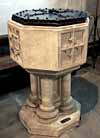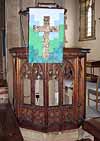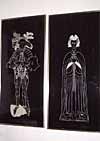For this church:    |
Wollaton St LeonardFeatures and FittingsThe Wollaton Antiphonal
The Wollaton Antiphonal is a 412-leaf handwritten and sumptuously illustrated book, which was used before the Reformation and contained the Latin words and musical notes for the daily services other than the Mass. It was then rescued from the church by the Willoughby family and spent almost 400 years in the library of Wollaton Hall, before being returned to the church by the 10th Lord Middleton in 1924. The only comparable survival is at Ranworth Church in Norfolk. It was created around 1430, probably in East Anglia, for the rich book collector Sir Thomas Chaworth and his wife Isabella. It spent its first thirty years in Sir Thomas's private chapel at his home, Wiverton Manor in Nottinghamshire. The Antiphonal was purchased for St Leonard's Church after Sir Thomas Chaworth's death in 1459 by the executors of the former rector, William Husse. It is an exceptional survival of an antiphonal, illustrated with beautiful miniatures and borders. Its size is remarkable. The parchment leaves on their own (without binding) are estimated to weigh 7 stones (45 kilograms). Much conservation work between 1997 and 2012 attempted to arrest the deterioration of the volume. The restored document is now in the continuing care of the University of Nottingham Manuscripts and Special Collections. University researchers have done a great deal to develop an understanding of this unique treasure and have made 75 of the more notable pages accessible to the public by digitising the original manuscript. This version offers magnification, interpretation and audio excerpts and visitors can 'turn the pages' electronically using a kiosk at both St Leonard's Church and the Lakeside Pavilion at University Park. Sections of the manuscript can also be viewed on the Nottingham University Manuscripts and Special Collections website. Sedile and piscina
A piscina and a sedile are situated in the south wall of the chancel. Two other sedilia appear to have been sacrificed to insert the arch surrounding the tomb of Sir Henry Willoughby. AltarThe altar is wooden, but nothing is known of its origins. It was lengthened by 2ft in 1925 at a cost of £25.
ReredosAlmost nothing is known about the reredos at the east end of the chancel. Pevsner dates it to the time of the Restoration in 1660, but there is no record of its designer, origin or the reason for its presence in the church. It is made of wood, though from a distance its current white appearance might suggest plaster. In 1902 Fellows stated that it was made of carved oak and moulded plaster. In 1847 the Rector, the Revd Charles Willoughby, reported in his diary that he had painted it and, in 1925, the architect C G Hare described it as 'very dull' and had it painted 'a beautiful tone of green'. This in turn seemed very dull by 1969, when it was painted white. At one point in the 19th century it was draped with hangings to reveal only the columns, cornice and broken pediment. Seating
Box pews formerly filled the church. The mid-19th century seating was replaced entirely by solid oak pews with simple crenellated ends at the restoration of the 1880s. Gradual further re-ordering has all but eliminated the 1970 benches to ease circulating space and 26 upholstered chairs were donated by members of the congregation to provide flexible seating in the chancel and elsewhere. A metal plaque on the north wall of the chancel reads:
Other plaques record the donors:
Each of the remaining 21 carry the words 'In Loving Memory of' followed by one or more names:
Some of the 19th century clergy stalls survive in appropriate positions in the chancel and nave. Font
In 1970 it was moved from a site on the north side of the nave facing the former south porch to a new baptistery area at the east end of the south aisle. When this space was required for the organ console in 1994, the font was relocated at the east end of the north aisle. In 2008 it was moved once more to form a more spacious baptistery in the south chancel aisle and once more, in 2015, to the south-west corner of the nave. A portable wooden font was donated in 1988 for use in a more central position in the nave. Lecterns
A smaller wooden lectern is inscribed:
Credence tablesA credence table is inscribed:
An earlier credence table is inscribed:
Processional crossA processional cross which is used at all services sung by the choir has the following inscription:
Pulpit
Altar cross and candlesticksThe source of the wooden cross and candlesticks in use at all main services is given on the former:
Case and table for book of remembrancePlate on the former:
Plate on the latter:
TextilesThere are two framed embroideries in silver thread on black fabric designed and produced by Irene Pitchford. These are based on brass-rubbings of the figures on the tomb of Sir Richard Willoughby in the chancel. In 1974 the same artist also produced a framed representation of the church's patron saint, St Leonard, in appliqué work. The following manuscript explanation is attached: Leonard (about AD485-560) was brought up at the court of Clovis I of France, and according to his legend obtained the king’s permission to release every prisoner whom he visited. He felt himself called to a monastic life and, after preaching the Gospel in Guyenne became the first abbot of Noblac Monastery near Limoges. St Leonard earned great popularity as a patron of prisoners since it was said that anyone in prison who called on his name was freed from all bonds and fetters. He is depicted as an abbot, holding a chain or fetter. At the entrance to the vestry a framed panel which recounts the life and works of St Leonard was presented in 2013 by Mike and Angela Suttill. Weathervane
The spire is surmounted by a weathervane in the form of an arrow. Its origin is not recorded, but Keith Train noted that the only other instance in Nottinghamshire is at Car Colston. He also observed that an arrow occurs in association with the Willoughby family emblem of the bouget on a roof boss at Willoughby-on-the-Wolds church, so there may be a connection with the family. A rare opportunity to see a weathervane at close quarters occurred in 1994 when it was repaired and regilded. As the photograph shows, the proximity of Mrs Dorothy Lawry, verger, and Mrs Mary Stacey, churchwarden, emphasises its size. |



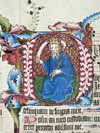

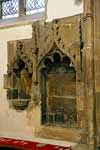

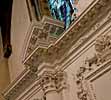
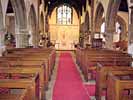

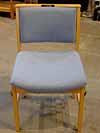
 JUNE MAUDE BROOKES & BOB ASHER
JUNE MAUDE BROOKES & BOB ASHER